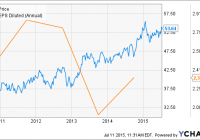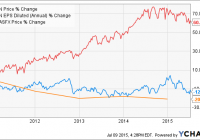Unitil Is Becoming Overvalued On A Forward Basis
Summary Northeastern electric and gas utility Unitil Corp. reported Q3 earnings last month that beat expectations on net income despite missing on revenue. The share price declined in the wake of the earnings release, due to a combination of profit-taking and concern over the company’s outlook over the next 6 months. A strong El Nino is developing across the U.S., and such events in the past have resulted in warmer-than-average winters across the company’s service area. With natural gas demand expected to be low through April, diminished earnings expectations, and high P/E ratios, I do not recommend Unitil as a long investment at this time. Small Northeastern electric and gas utility Unitil Corp. (NYSE: UIL ) reported Q3 earnings late last month that beat slightly on net income despite missing on revenue. The company’s shares have lost almost 10% of the value since the earnings report’s release, however, suggesting that even the beat didn’t meet investors’ expectations. In a bullish article on the company written back in June, I highlighted management’s plans to increase the penetration of its natural gas services in an area that has historically been dominated by heating oil, concluding that current investors should maintain their positions. The company’s share price rose by 17% over the subsequent four months, as an expected Federal Reserve interest rate hike failed to materialize. The company’s short-term outlook has diminished somewhat since then, as an especially strong El Nino has begun to make its presence felt. This article reconsiders Unitil Corp. as a long investment opportunity. Q3 earnings report Unitil reported Q3 revenue of $74.7 million, down by 2.5% YoY (see table) and missing the consensus analyst estimate by $7.4 million. The decline and miss were attributable to the company’s electric utility segment, which reported a revenue decline of $2.8 million YoY to $51.4 million due to lower rates. An increase in kWh sales of 1.1% over the same period, split between the company’s residential, commercial, and industrial customers, was insufficient to prevent the revenue decline. The natural gas utility segment’s revenue increased slightly by $0.8 million YoY to $21.7 million despite the presence of lower rates during the quarter, with gas therm sales increasing by 4% over the same period as strong demand from commercial and industrial customers offset weakness from residential customers. The gas utility segment also reported a 1.4% increase in customers compared to the previous year, further offsetting the impact of lower rates. Finally, Unitil’s non-regulated Usource segment reported revenue of $1.6 million, virtually unchanged from the previous year’s result. Unitil Corp. Financials (non-adjusted) Q3 2015 Q2 2015 Q1 2015 Q4 2014 Q3 2014 Revenue ($MM) 74.7 77.5 172.2 119.8 76.6 Gross income ($MM) 40.0 40.1 61.6 50.7 39.3 Net income ($MM) 1.7 1.7 13.6 9.4 1.6 Diluted EPS ($) 0.12 0.12 0.98 0.68 0.11 EBITDA ($MM) 18.7 20.1 39.8 31.3 18.5 Source: Morningsta r (2015) The company’s electric sales margin came in at $22.2 million, down slightly YoY, as a large decline to the segment’s cost of revenue resulting from the presence of lower fuel prices during the quarter offset the aforementioned revenue decline. The gas segment’s margin came in at $16.7 million, up YoY by $1 million, as a similar decline to its cost of revenue complemented its revenue increase. O&M and income tax expenses both fell over the same period, although the impacts were offset by higher depreciation and interest expense costs. Unitil reported net income of $1.7 million, up by 11.1% from $1.6 million in the previous year. This generated a diluted EPS of $0.12 for the most recent quarter, up from $0.11 in the previous year, and beating the analyst consensus estimate by $0.01. EBITDA came in at $18.7 million, up slightly from $18.5 million over the same period. Including the Q3 results, the company is on pace to report a 9.7% allowed return on equity for the TTM period, an achievement that management attributes to the presence of cost trackers. Unitil also reported a number of positive developments during Q3 in addition to its earnings beat. First, it extended the duration of its credit facility by two years to 2020, while simultaneously reducing its interest rate by 0.125%. With sufficient liquidity in place following this move, management announced a 1.4% dividend increase compared to the previous year. While lower than those increases reported by many of its peers, the increase does leave it with an attractive forward yield of 4%. The company stated that the penetration of its natural gas utility segment into its service area increased to 60% during the quarter. While this is low relative to its system potential, natural gas is a relatively new arrival in the Northeast as a heating fuel, with heating oil having a lengthy history there instead. The company’s future earnings expectations are based on the assumption that natural gas will continue to make inroads. Finally, Unitil is asking Maine to approve the implementation of a rate surcharge mechanism for the natural gas segment that will enable proactive expansion and replacement of its existing distribution infrastructure, thereby minimizing regulatory lag and maximizing the company’s ability to initiate its planned capex spending. Outlook Unitil’s management expects the natural gas utility segment to be the major driver of its earnings growth moving forward, stating during the Q3 earnings call that it anticipates annual rate base growth of 10% for the gas utility, compared to only 4% for the electric segment. This expectation is, in turn, being driven by the continued presence of low natural gas prices, especially compared to those seen in previous years. While natural gas has already begun to replace heating oil in many Northeastern buildings, the percentage of residential homes using natural gas in Massachusetts, for example, is still lower at 44% than the U.S. average of 51%. Maine, which is home to most of the natural gas utility segment’s service area, has natural gas penetration of only 4% . Likewise, the percentage of homes heating with electricity in both states is also well below the national average. Inexpensive natural gas provides consumers with a major incentive to convert from heating oil, which is both relatively dirty and a fire risk, to natural gas. This incentive becomes especially pronounced when natural gas prices exhibit low volatility, as has been the case for the last two quarters. Increased adoption of natural gas by utility customers presents Unitil with a substantial future growth opportunity, primarily due to the relative lack of natural gas penetration within the gas segment’s own service areas. The company can bring in new customers without needing to build additional pipelines or move into new service areas and potentially unknown regulatory schemes; instead, it just needs to build the necessary distribution infrastructure within the existing service area. While Unitil’s long-term growth drivers remain in place, its share price is at risk of a decline in the near term due to weather-related impacts. This year’s El Nino event is now expected to be an especially strong one, and its effects have already begun to be felt across the U.S. Unitil’s service area has experienced warmer-than-average temperatures between October and April during previous El Nino events, resulting in fewer heating degree days than average. The timing of this impact could not be worse for the company’s earnings given that the large majority of its annual earnings are reported in Q4 and Q1 due to its heavy exposure to natural gas, which is primarily utilized for space heating in the service area. This impact could be partially offset by higher-than-average precipitation in the Northeast coastal states, with humidity making it feel colder than it actually is. Overall, however, I expect Unitil’s Q4 earnings in particular to come in under expectations and fall on a YoY basis. Valuation The consensus analyst estimate for Unitil’s EPS in Q4 has held steady over the last 90 days, although the FY 2016 consensus estimate has declined. The FY 2015 estimate has remained at $1.89, while the FY 2016 estimate has decreased from $1.96 to $1.91 over the same period. Based on a price of $34.79 at the time of writing, Unitil’s shares are trading at a trailing P/E ratio of 18.3x and forward ratios of 18.4x and 18.2x, respectively. All three of these ratios are above their long-term averages, with the latter, in particular, approaching a 3-year high. High ratios could be justified in the event that the company offered either an especially high forward dividend yield or strong near-term earnings growth potential. While the forward yield is relatively attractive at 4%, this is offset by a lack of near-term earnings growth potential (a mere 1% in FY 2016 if the consensus estimates are correct) and a negative short-term outlook due to El Nino. Conclusion Unitil reported Q3 earnings that beat on net income despite missing on revenue, although investors were ultimately not impressed. While some of the share price’s subsequent decline can be attributed to profit-taking in the wake of its earlier Fed-induced increase, the fact that the company’s winter outlook has been diminished at the same time due to El Nino is also likely weighing on shareholders. With minimal earnings growth expected in FY 2016, the likelihood that warm Q1 and early Q2 temperatures will have a disproportionately negative impact on Unitil’s earnings, and higher-than-average forward P/E ratios, I cannot recommend the company as an attractive long investment opportunity at this time. El Nino and a potential interest rate hike early next year provide too much potential downside risk, although they could also create a potential buying opportunity given the company’s more favorable long-term outlook. Dividend investors should wait for a falling share price to make the company’s forward yield even more attractive before placing any buy orders.

